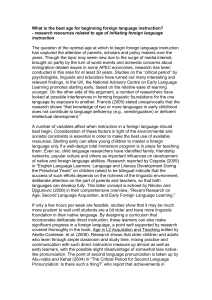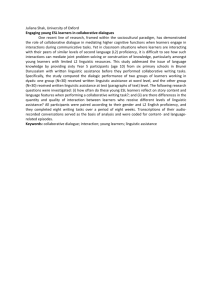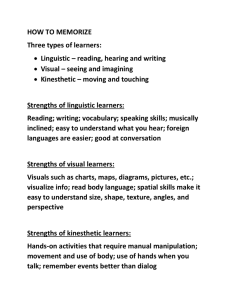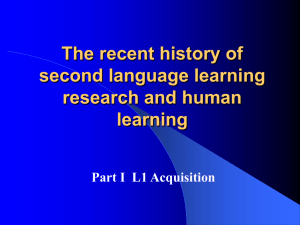Larsen-Freeman2008Ha..
advertisement
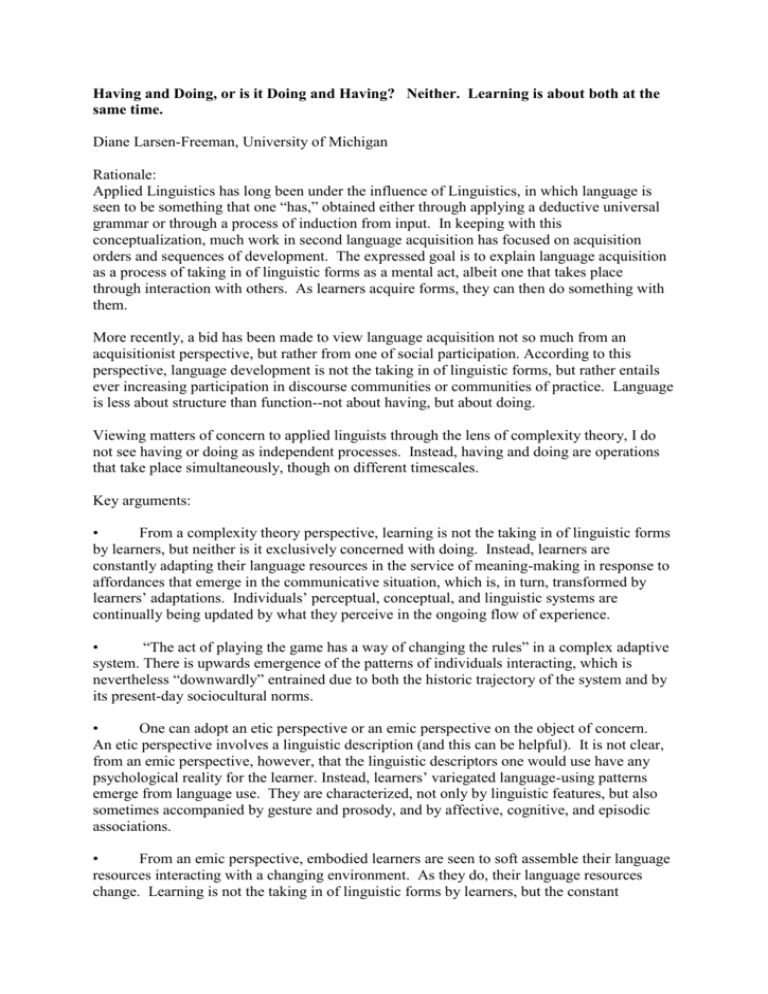
Having and Doing, or is it Doing and Having? Neither. Learning is about both at the same time. Diane Larsen-Freeman, University of Michigan Rationale: Applied Linguistics has long been under the influence of Linguistics, in which language is seen to be something that one “has,” obtained either through applying a deductive universal grammar or through a process of induction from input. In keeping with this conceptualization, much work in second language acquisition has focused on acquisition orders and sequences of development. The expressed goal is to explain language acquisition as a process of taking in of linguistic forms as a mental act, albeit one that takes place through interaction with others. As learners acquire forms, they can then do something with them. More recently, a bid has been made to view language acquisition not so much from an acquisitionist perspective, but rather from one of social participation. According to this perspective, language development is not the taking in of linguistic forms, but rather entails ever increasing participation in discourse communities or communities of practice. Language is less about structure than function--not about having, but about doing. Viewing matters of concern to applied linguists through the lens of complexity theory, I do not see having or doing as independent processes. Instead, having and doing are operations that take place simultaneously, though on different timescales. Key arguments: • From a complexity theory perspective, learning is not the taking in of linguistic forms by learners, but neither is it exclusively concerned with doing. Instead, learners are constantly adapting their language resources in the service of meaning-making in response to affordances that emerge in the communicative situation, which is, in turn, transformed by learners’ adaptations. Individuals’ perceptual, conceptual, and linguistic systems are continually being updated by what they perceive in the ongoing flow of experience. • “The act of playing the game has a way of changing the rules” in a complex adaptive system. There is upwards emergence of the patterns of individuals interacting, which is nevertheless “downwardly” entrained due to both the historic trajectory of the system and by its present-day sociocultural norms. • One can adopt an etic perspective or an emic perspective on the object of concern. An etic perspective involves a linguistic description (and this can be helpful). It is not clear, from an emic perspective, however, that the linguistic descriptors one would use have any psychological reality for the learner. Instead, learners’ variegated language-using patterns emerge from language use. They are characterized, not only by linguistic features, but also sometimes accompanied by gesture and prosody, and by affective, cognitive, and episodic associations. • From an emic perspective, embodied learners are seen to soft assemble their language resources interacting with a changing environment. As they do, their language resources change. Learning is not the taking in of linguistic forms by learners, but the constant adaptation of language-using patterns that emerge in interaction with a dynamic communicative situation. • Learners learn to use language through repeated activity in slightly different situations. Learning is not a linear, additive process, but an iterative one. When we say that someone “has” some linguistic structure, we mean that the contextual and individual conditions are such that the learner has zoomed in on some stable, but not static, pattern. It follows, then, that learning is not only embodied, it is also situated and inextricably linked to history. Methodology: Many extant research methods, such as ethnography and computer modeling, are appropriate for a complexity theory approach to the study of learning. Others, such as classic experiments, are less successful. Several criteria are important in any methodology informed by complexity theory, among which are investigating all the variability of learner performance, recognizing the nonlinearity of the learning process, and avoiding predictions. Predictions may work in the physical sciences, but do not work well in activities that are mediated through human judgments, assessments, values, identities, positioning, stancetaking, and desires. For these, retrodiction is preferred. Experiments which involve retrodiction, such as formative and design experiments, are more appropriate. Epistemology: Our knowing is informed by a theoretical commitment to complexity theory and by adopting its dynamic perspective on language use by language learners. In addition, computer modeling and neurobiological research show that experience shapes neural networks in ways that are sensitive to frequencies. Discussion: Teaching and learning languages do not involve the transmission of a closed system of knowledge. Thus, learners are not engaged in learning fixed forms or sentences, but rather in learning to adapt their behavior to an increasingly complex environment. In some cases, morphogenesis, or the creation of new patterns, results. What motivates development is some discrepancy between what the learner wants to say and what she or he is able to say. Second language learning is thus a dialectic process in which development is driven by the inadequacy or instability created by the thesis of the learner’s current language resources and the antithesis provided by internal and external feedback. In addition, it is the role of the teacher, in negotiation with students, to establish the constraints that will help learners to further develop their repertoire of language-using patterns. Doing so will likely be facilitated through syntactic coordination and zipfian profiles. Conclusions: There are many ways to conceptualize learning in applied linguistics. One way that has occupied center stage for some time is to see language teaching as presenting linguistic forms and language learning as a process of taking them in. I have called this the “having” view. A second conceptualization adopts a more functional approach to language. Language teaching is more about guiding students to get their message across, and language learning is developing discursive routines through participation in communities. I have called this the “doing” view. In this paper, I make the case for language as a complex adaptive system, in which every use of language changes the language resources of the learner/user and the changed resources then are potentially available for the next speech event. This view suggests a unity not only between doing and having, between real-time processing and development, but also between language use and evolution.


